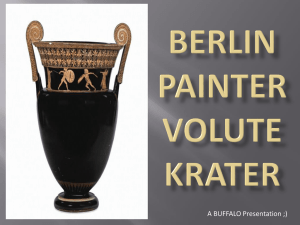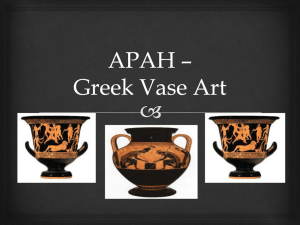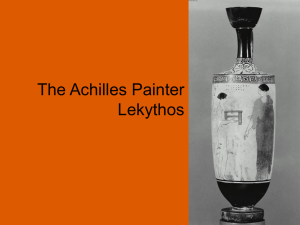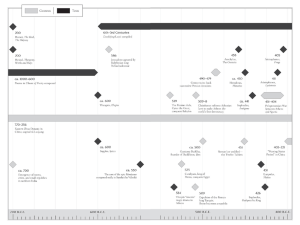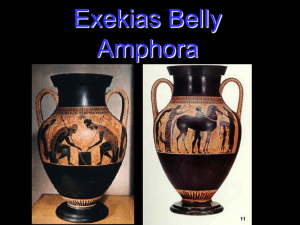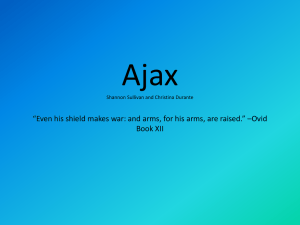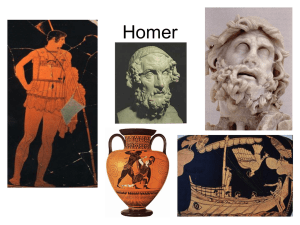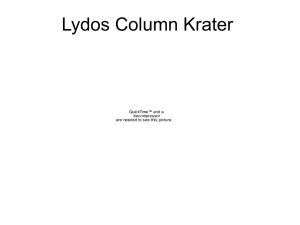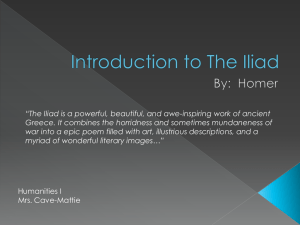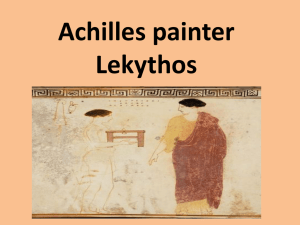Berlin Painter: Volute Krater
advertisement
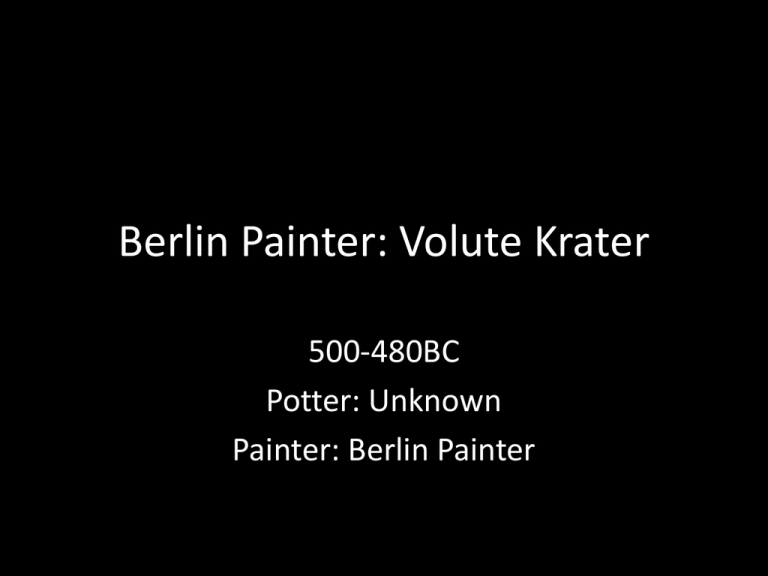
Berlin Painter: Volute Krater 500-480BC Potter: Unknown Painter: Berlin Painter 65cm tall Why ‘The Berlin Painter’? • The painter never inscribed his own name on his work. An amphora was found in Berlin, after which this nickname was coined. This amphora is stylistically very similar to the volute krater so we can assume it is by the same painter. The Shape • Volute Krater • Used for mixing wine and water at symposium • Handles of this krater are different to other types of kraters. This krater is also very stylised. • The volute krater is the perfect shape because it has a large belly and wide mouth so vessels can be dipped in to it. Inscriptions • The inscriptions on the vase are the names of the figures • These inscriptions are part of narrative technique – naming characters helps the painter to convey what is happening on the vase. The Scene • The figure on the right is Athena • She is wearing her snake-covered aegis • She can also be identified by her helmet and spear The Scene: Side A • • • • Achilles and Hector Athena Apollo A depiction of a battle in the Trojan War between Greek hero and Trojan prince. The heroes are urged on by their respective patrons. Achilles is then killed by Paris, with the help of Apollo, as revenge for the deaths of Hector and Troilus. Narrative Technique • Raised feet indicate movement – Apollo is leaving the doomed Hector and waving farewell. The arrow is perhaps a hint of the fate that awaits Achilles. • Swirling drapery shows movement • Naming characters using inscriptions Narrative Technique • Knees are bent as if stumbling backwards • Blood is spurting from wounds on his chest and leg • Depicted totally unprotected with his shield twisted around him Narrative Technique • Raised feet, legs moving forward, ready to attack • Interior view of shield highlights Achilles, compared to Hector appearing deliberately weak because of the placement of his shield The Scene: Side B • Achilles and Memnon (Priam’s brother and King of Ethiopia) • Thetis the sea-nymph (mother of Achilles) • Eos the goddess of the dawn (mother of Memnon) • After the death of Achilles’ ‘cousin’ Patroclus, Achilles closest companion was Nestor’s son Antilochus. Memnon killed Antilochus so Achilles sought revenge, as with Hector. The heroes’ mothers rushed to Zeus, who weighed their destiny and found Memnon’s the heaviest. Narrative Technique • Hand gestures – Eos pulls her hair out in anguish, realising her son may die • Raised feet – moving towards her son • Swirling drapery • Emotional realism Narrative Technique • Raised feet – indicating movement and battle • Memnon holds up his shield to block Achilles’ spear while preparing to strike • Achilles’ twisting ¾ pose indicates movement Composition • 2nd band on the neck • The Francois Vase fills space, groups figures, uses overlapping to create depth = Corinthian minituarist Composition • A comlpex mirrored lotus and palmette chain – contrasts with the earlier black figure examples, and with those of Euphronios. • A singular ground line with a tongue pattern • Figures are set in W shape which mimics the shape of the vase. This is emphasised by the clashing of spears on the opposite side. • The positioning of shields helps give depth and a 3D effect • The scene is symmetrical on both sides – the ¾ pose of Achilles is mirrored • The illustration comes from the neck of the krater Composition • The vessel shows a reversal of the major artistic trend – no decoration on the body except for a coating of shiny black glaze, and a band of stylised rays at the base of the belly. • Compared to the Kleophrades Painter Hydria which has a complex scene with many figures over a large proportion of the vase. Composition • Only the neck and handles are decorated, which is one of the attractions of The Berlin Painter • The body is entirely black apart from a small band of rays at the base above the foot. This draws attention to the shape of the elegant volute krater. The sheer mass of the glossy black body draws attention to the figured scene. Composition • Large areas of black slip without decoration are typical to The Berlin Painter • Other vases by The Berlin Painter feature singular figures spotlight on a plain black background, without the framing of supporters of patterns. The Berlin Painter: Bell Krater 490-480BC Composition • Two central figures are engaged in battle with their supporters framing them • W shape of figures on both sides, which also mimics the shape of the volute kraters • The figures sit on a single ground line Painting Technique • • • • • • • Red-figure technique The figures were painted with a relief line first The background was then painted with a black slip Honey-coloured dilute glaze is used for shading Red slip used for blood Purple slip? Dilute slip was also used for detail on the shields, Achilles’ hair, detaling the musculature and painting the major muscles. • In black-figure vases women were painted white, while in red-figure women are painted in the same way as men Comparison!
